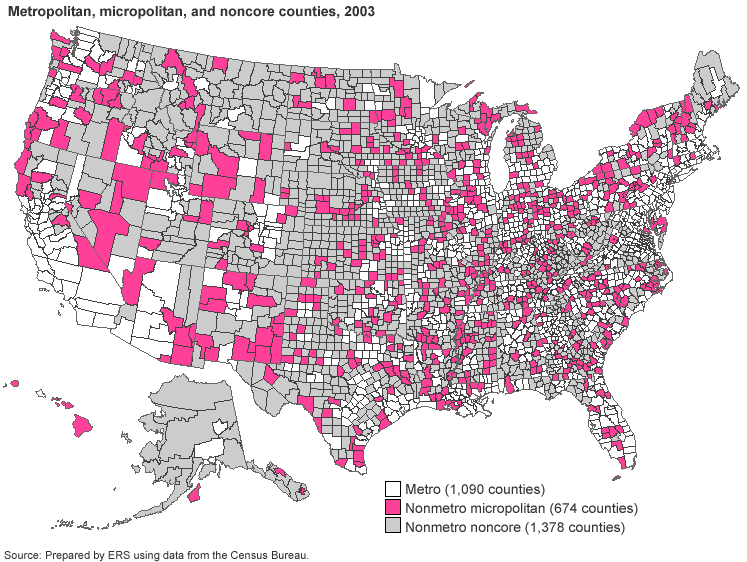Office of Management and Budget (OMB) was urged by various sources in
the last decade to delineate the entire land surface of the country into
areas, and not leave the territory outside of metro areas as an undifferentiated
residual. As a partial response, OMB designated micro areas using the
same procedure as that for metro areas. Any nonmetro county with an urban
cluster of at least 10,000 persons or more becomes the central county
of a micro area. As with metro areas, outlying counties are included if
commuting to the central county is 25 percent or higher, or if 25 percent
of the employment in the outlying county is made up of commuters from
the central county. Because they are county-based and include outlying
areas, the total area population reaches well beyond 50,000 for many micro
areas. The inaugural set of 560 micro areas includes 674 counties and
ranges in size from 13,000 (Andrews, Texas) to 182,000 (Torrington, Connecticut).
Micro areas contain just under 60 percent of the nonmetro population,
with an average of 43,000 people per county. In contrast, the 1,378 "noncore"
counties, with no urban cluster of 10,000 or more residents, average just
14,000 people. In general, lack of an urban core and low overall population
density may place these counties at a disadvantage in efforts to expand
and diversify their economic base. However, the population in noncore
counties grew by 7.9 percent during the 1990s, compared with a growth
rate of 9.9 percent in micro areas and 14 percent in metro areas.
OMB's new designation of micro areas is an important step in recognizing
nonmetro diversity. It provides a framework for better understanding population
growth and economic restructuring in small towns and cities that up to
now have received less attention than metro areas. Micro areas embody
a widely-shared residential preference for a small-town lifestyle—the
ideal compromise between large urban and completely rural settings. As
information about these places makes its way into government data and
publications alongside metro areas in the coming years, micro areas will
draw increased attention from policymakers and the business community.

For more infomation, see
Metropolitan and Micropolitan Statistical Areas on the U.S.
Census Bureau's website. Definitions, maps, and lists of the new
and old statistical areas are provided.
Download
an Excel file with a list of the current metropolitan and micropolitan
areas by county.
for more information, contact:
John Cromartie
web administration: webadmin@ers.usda.gov
page updated: August 22, 2003
|